Range Anxiety
Range anxiety is the fear or concern that an electric vehicle (EV) will run out of battery power before reaching its destination or a charging station.
Overview
Range anxiety is one of the most widely discussed challenges in the adoption of electric vehicles. It reflects driver uncertainty about whether the EV has enough battery capacity to complete a trip, particularly in areas with limited charging infrastructure.
This concern is rooted in the comparison with gasoline vehicles, where fuel stations are abundant and refueling is quick. In contrast, EV charging requires longer refueling times, strategic planning, and awareness of charging station availability.
Automakers, policymakers, and charging providers are addressing range anxiety through higher-capacity batteries, rapid charging networks, and advanced navigation systems. These advancements aim to reassure drivers that electric vehicles are just as practical and reliable as conventional cars.
How Does It Work?
Range anxiety arises from a combination of psychological and technical factors:
-
Battery State of Charge (SoC) – Drivers worry when the displayed range is insufficient for their journey.
-
Charging Infrastructure Gaps – Lack of accessible or fast-charging stations intensifies the fear of being stranded.
-
External Conditions – Driving style, terrain, traffic, and weather (cold temperatures reduce battery efficiency) can lower real-world range compared to manufacturer estimates.
-
Perception vs. Reality – Even when EVs have adequate range, unfamiliarity with charging options amplifies the perceived risk.
Modern EVs combat this with real-time range estimation, smart route planning, and regenerative braking systems to extend driving distance and reduce anxiety.
Features of Range Anxiety
-
Psychological Impact – A driver’s confidence in EV usability is directly tied to perceived charging convenience.
-
Context-Dependent – More common on long journeys or in regions with poor charging networks.
-
Declining Trend – Improvements in EV technology and infrastructure are steadily reducing driver concerns.
-
Technology-Driven Mitigation – Features like over-the-air updates, AI route planning, and predictive battery management address these worries.
Applications in EV
While range anxiety itself is a challenge, it has led to innovations across the EV ecosystem:
-
Longer-Range Batteries – Tesla, Lucid, and Mercedes EQ models now exceed 500 km per charge, reducing driver stress.
-
Fast-Charging Networks – Networks like Tesla Supercharger, Ionity, and Electrify America help eliminate long-distance travel concerns.
-
Smart Navigation Systems – EVs like Hyundai IONIQ 5 and BMW iX offer charging-aware route planners, guiding drivers to optimal stations.
-
Consumer Education – Awareness campaigns and transparent range testing (e.g., WLTP, EPA ratings) help drivers set realistic expectations.
Conclusion
Range anxiety represents both a psychological barrier and a practical challenge in the EV adoption journey. While once a dominant concern, advances in battery technology, charging infrastructure, and intelligent navigation are rapidly diminishing its impact. As confidence grows and infrastructure expands, range anxiety will transition from a critical barrier to a fading memory, reinforcing the practicality and reliability of electric mobility.

